Yaich TIMSIT, 1905 – 1944
We are a class of 9th grade class at the International School of Casablanca, in Morocco. We and our teacher, Ms. Zriwil, first heard about the Convoy 77 project in February 2020. We found the idea of the project interesting: we were to tell the story of Yaich Timsit, a Jewish man from Morocco who was deported to Auschwitz on the last large convoy, in July 1944.
This project required us to take on the role of investigators. We also had to work around the current health situation. Thanks to the help of the French National Office for Veterans and Victims of War, we had access to various historical documents that helped us in the creation of this biography. But we needed more… We therefore sought to contact Yaich’s family, and we found them. We also contacted Mr. Farid El Asri, anthropologist and Doctor in Political and Social Sciences at the Catholic University of Louvain, Belgium (ULC), Associate Professor at Sciences Po Rabat, Morocco (UIR) and Associate Researcher at the CNRS, the French National Center for Scientific Research; and Mr. Michel Boyer, Doctor in History of International Relations and former Senior Officer, Associate Professor at Sciences Po Rabat (UIR).
This was all a great adventure for us, which ended with the making of a short film. Here is Yaich Timsit’s life story.
On Sunday, April 23, 1905, in Mogador (now Essaouira), in Morocco some wonderful news filled the hearts of the Timsits: the arrival in the world of their son Yaich, יאִשׁ, يعيش. This is an Israeli first name whose Arabic meaning means “to be alive”. The name held such a powerful, iconic meaning for us. That’s what prompted us to become “passers-on of history”: by honoring Yaich’s memory, we hope to bring out the real meaning of his first name.
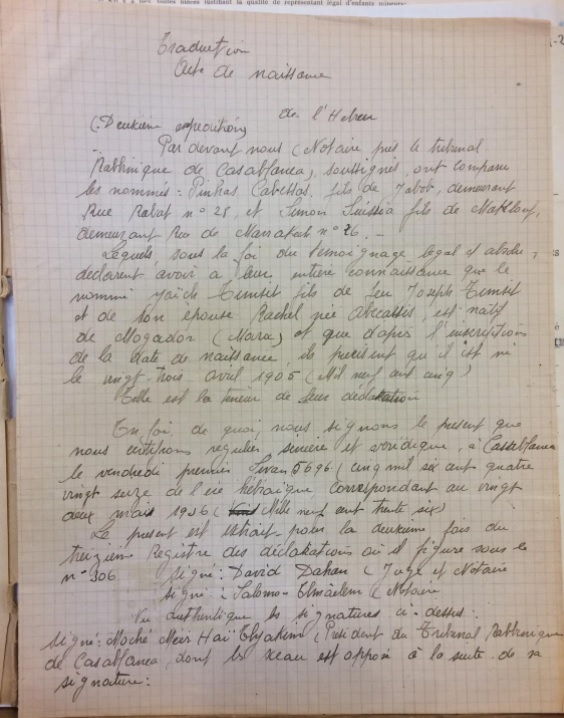
Yaich Timsit’s birth record
Since we could not travel to Essaouira, we tried to contact the Jewish museum of Essaouira, Bayt Dakira, but to no avail. We were therefore most interested in a documentary about the history of Essaouira, which provided us with some valuable information about Yaich’s background.
He was the son of Joseph Timsit, a merchant in Mogador, and Rachel Timsit, née Abecassis. They lived in harmony with the Muslim community. They lived in the Mellah, a neighborhood exclusively reserved for Moroccans of the Jewish faith. Yaich went to the Alliance Israélite Universelle school, as did the other children of the same religion.
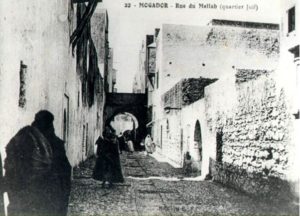
Rue du Mellah, Mogador (Essaouira)
In the 1910s, Yaich and left Morocco for the first time and travelled with his parents to France. At that time, there were more than 15,000 Moroccan workers in France.
In 1914, when he was only 9 years old, the First World War began. It was a war of annihilation, in which women played an important role, as they replaced men in the factories. His father continued to work as a laborer and did not serve in the war.
Meanwhile, Yaich grew up and pursued his childhood dreams. He hoped for a more prosperous future. He became an accomplished and distinguished young man. It was then that he met Hassiba Alice Suissa, a young Moroccan woman, also a Jew and a native of Mogador. He fell in love with her and saw himself building a future with her.
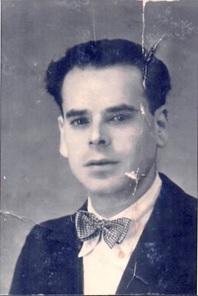
Photo of Yaich Timsit
On March 15, 1933, at the age of 28, he married the love of his life at the Synagogue in Casablanca, where they vowed to stay together and to respect each other forever, for better or for worse. The young couple went to live in the Mellah district of Casablanca, where they lived for a time at 30, rue Worthington, now rue Mohammed Tabit.

Yaich Timsit and Hassiba Alice Suissa’s marriage record
The crash of 1929 caused the Moroccan economy to collapse. Many people decided to emigrate to countries where the situation was more stable. Between the wars, on the other side of the Mediterranean, France was in the midst of emancipation: the Matignon agreements allowed for wage increases, ensured freedom of association, and established collective agreements. The working week was reduced from 48 to 40 hours, and employees were guaranteed two weeks paid vacation.
As a result, Yaich Timsit decided to return to France. He felt that a better future awaited them in that part of the world. His dream would soon come true, as he would go to work at the Saint-Gobain Glass and Chemicals Factory in Saint-Fons, near Lyon in the Rhône area of France, where he had previously worked as a mechanic.
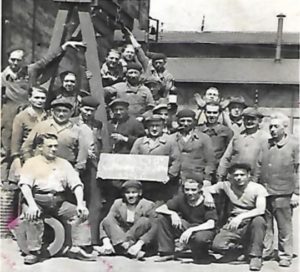
Yaich Timsit – first row on the right, squatting (1940), while employed at the Saint Gobain factory in Saint Fons
It was there that Yaich and his wife, Alice, started their family, which was made up of Joseph, their eldest child, born May 27, 1934, Henri, born October 22, 1936, and Simon, born January 20, 1941.
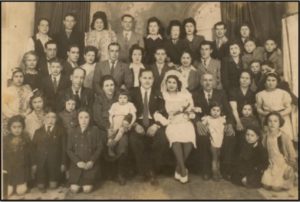
Yaich Timsit – back row, 4th from the left, at the marriage of his niece in 1943
On September 1, 1939, the world went to war again. It was the beginning of a global ideological conflict.
In 1940, France was attacked by Nazi Germany and defeat was swift. There was widespread panic, which caused a mass exodus of people to the south of France, where they hoped to escape from the advancing German troops.
The government lost, and Marshal Pétain came to power. He thus became President and put an end to the Third Republic, forming what was known as the Vichy regime. He then asked the Germans for an armistice and as a result, France was divided in two. The north and the west of the country made up the area occupied by the Germans, while the south was known as a free zone. A demarcation line separated the two zones.
In the Rhône area, Lyon was the center of the Jewish Resistance movement. Yaich continued to work at the factory. He remained confident that he would not become a victim of the war. However, increasing numbers of people were arrested, tortured and deported and in July 1944, the situation became worse than ever.
It was a Wednesday afternoon, June 7, 1944 when Yaich, who was by now 39 years old, had just finished a long day at work and was looking forward to going home to his family. However, the Germans stopped him on the way, arrested him and transferred him to Drancy camp.
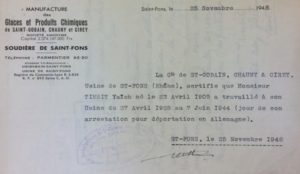
Yaich Timsit’s work report, which mentions the “day of his arrest for deportation to Germany”.
Having no news of her husband, Alice sent a letter to the Minister of Deported Prisoners and Refugees in Paris on October 9, 1944:
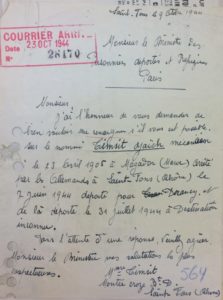
Alice Timsit’s letter to the Minister of Deported Prisoners and Refugees, in Paris (1944).
What she did not know, as she wrote this letter, was that Alois Brunner, the commander of the Drancy camp, had already organized the last of the large convoys to Auschwitz. Convoy 77 left Drancy on July 31, 1944, carrying 986 men and women and 324 children. Yaich’s death warrant was issued there and then.
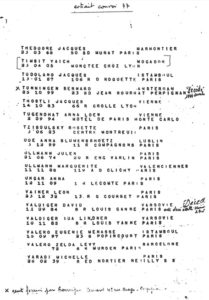
Extract from the list of Convoy 77 deportees
Something else she didn’t know about was the horror he experienced on that convoy. First of all, the cattle cars, in which they were all piled up like corpses, even though they were alive. Yaich was tattooed, beaten, threatened, and then murdered. And yet, the Dachau song rang round:
“Charged with death, high tension wire
Rings around our world a chain.
Pitiless a sky sends fire,
Biting frost and drenching rain.
Far from us is lust for living,
Far our women and our town
When we mutely march to toiling
Thousands into morning’s dawn.
But we all learned the motto of Dachau to heed
And became as hardened as stone
Stay humane, Dachau mate,
And work as hard as you can, Dachau mate,
For work leads to freedom alone!
Faced by ever-threatening rifles
We exist by night and day.
Life itself this hell-hole stifles
Worse than any words can say.
Days and weeks, we leave unnumbered
Some forget the count of years
And their spirit is encumbered
With their faces scarred by fear.
But we all learned the motto of Dachau…
Lift the stone and drag the wagon
Shun no burden and no chore
Who you were in days long bygone?
Here you are not anymore.
Stab the earth and bury depthless
All the pity you can feel,
And within your own sweat, hapless
you convert to stone and steel.
But we all learned the motto of Dachau…
Once will sound the siren’s wailing
Summons to the last roll-call.
Outside then we will be hailing
Dachau mates uniting all.
Freedom brightly will be shining,
For the hard forged brotherhood
And the work we are designing
Our work it will be good.
For we all learned the motto of Dachau…
(Translator’s note. This is a slightly edited English translation of the original lyrics of the Dachaulied, as they appear in Paul Cummins’ biography of Herbert Zipper. The poem was originally written by Jura Soyfer and Herbert Zipper wrote the music. The two men had been friends in Vienna in the 1930s, and in the summer of 1938, they again met up in Dachau, where they wrote the song. Soon afterwards, they were transferred to the Buchenwald camp)
We tried to comprehend what Yaich Timsit went through, but it was beyond anything we had ever known… We were also interested in the testimonies of former deportees who survived, including that of Henri Kichka, who said that: “The worst thing was the food, when there was any … dry bread and soup. We were dying, we were garbage, I was half way to becoming a cadaver.”
Alice never got to say goodbye to her husband. All she had was a letter, telling her of her husband’s death.
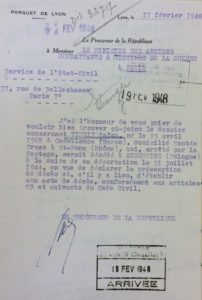
Reply from the Minister of Prisoners, Deportees and Refugees, in Paris (1948)
In order to honor her late husband, Habiba Alice Timsit sent another letter to the Minister of Veterans Affairs in Paris on Monday, December 6, 1948. She asked for her husband to be granted the status of “Died for France”.
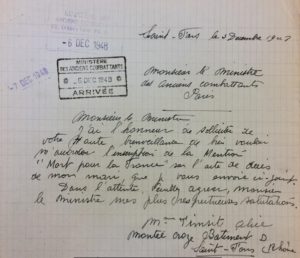
Alice Timsit’s letter to the Minister of Veterans Affairs (Paris) – 1948
Her request must have been granted, since the words were later inscribed on Yaich Timsit’s death certificate.
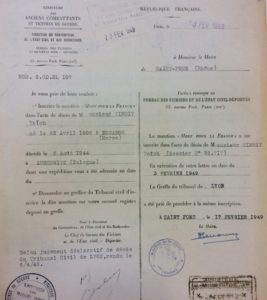
Inscription of the words “Died for France” on Yaich Timsit’s death certificate – February 3, 1949
Elie Wiesel said “All peoples who do not know their history are called upon to relive it”. Thanks to you Yaich, we have a memory of the past and also a vision of the future.

يعيش تمسيت 1905-1944
1905-1944/الولادة : الصويرة، المغرب / الاعتقال : سان-فونس / الإقامة : الدار البيضاء، الصويرة، المغرب، سان-فونس
في شهر فبراير 2020، اكتشف قسمُنا الدراسي الثالثة 3، في المدرسة الدولية بالدار البيضاء بالمغرب، تحت إدارة السيدة زريويل، مشروع القافلة 77. بدتْ لنا فكرة هذا المشروع مهمة: وهي حكْي قصة يعيش تمسيت، مواطن مغربي من ديانة يهودية توفي إبان ترحيله نحو أوشفيتز في آخر قافلة لشهر يوليوز 1944.
لإنجاز هذا المشروع، تقمّصنا صفة مُحققين. وقد تكيّفنا أيضا مع السياق الصحي المرتبط بجائحة كوفيد، وبفضل مساعدة المكتب الوطني لقدماء المحاربين وضحايا الحرب تمكّنا من الاطلاع على عدة وثائق أرشيفية والتي وجّهتنا في إنجاز هذه السيرة. ولكنّ حاجتنا كانت أكثر من ذلك… فقد حاولنا كذلك الاتصال بعائلة يعيشْ وعثرنا عليها. كما ربطنا الاتصال بالسيد فريد العسري، أنثربولوجي، دكتور في العلوم السياسية والاجتماعية بالجامعة الكاثوليكية في لوفان، وأستاذ مشارك في معهد العلوم السياسية بالرباط التابع للجامعة الدولية بنفس المدينة، وهو أيضا باحث مشارك بالمعهد الوطني للبحث العلمي في فرنسا، وكذا بالسيد ميشيل بوايي، دكتور في تاريخ العلاقات الدولية وضابط سام سابق، أستاذ بمعهد العلوم السياسية بالرباط.
كان ذلك بالنسبة لنا مغامرة جميلة انتهت بإنجاز شريط قصير، وفيما يلي قصة يعيش تمسيت.
يوم الأحد 23 أبريل 1905 بمدينة موغادور-الصويرة بالمغرب، تلقّى تمسيتْ خبرا ملأ قلبه : ألا وهو ولادة ابنه يعيشْ، وهو اسم شخصي يهودي يفيد معناه باللغة العربية “البقاء حيا”. هذا الاسم الشخصي كان بالنسبة لنا ذا دلالة قوية وإشكالية. وهو ما جعلنا نتحوّل إلى “ناقلين للتاريخ” من خلال تكريم ذاكرة يعيش، نأمل إعطاء المعنى الكامل لهذا الاسم الشخصي.
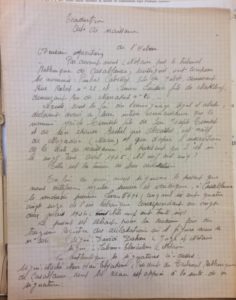
عقد ازدياد تمسيت يعيش
بما أننا لم نتمكنْ من الانتقال إلى الصويرة، فقد حاولنا الاتصال بالمتحف اليهودي هناك “بيت الذاكرة” ولكن دون جدوى. ولذا استفدْنا من وثائقي عن هذا الأخير مكّننا من الحصول على معلومات أكثر عن طفولة يعيشْ.
يتعلق الأمر بجوزيف تمسيت، تاجر بموغادور، وراشيل تمسيت من عائلة أبيكاسيس. كانا يعيشان مع الطائفة المسلمة. وكانا يقطنان بالملاّح، وهو حي مخصص للمغاربة من الديانة اليهودية. كان يعيشْ يذهب إلى مدرسة الرابطة الإسرائيلية العالمية، مثل باقي الأطفال من نفس الديانة.

زقاق ملاح موغادور-الصويرة
في سنوات 1910، غادر تمسيتْ المغرب للسفر في مرة أولى مع والديه إلى فرنسا. كان وقتها بفرنسا حوالي 15 ألف عامل مغربي.
وفي 1914، وسنه وقتها تسع سنوات، عرف العالم الحرب العالمية الأولى. كانت حرب فناء وكان للنساء فيها دور هام لأنهنّ عوّضن الرجال بالمعامل. استمر والده في ممارسة مهنة عامل ولم يشارك في الحرب.
وفي تلك الأثناء، كان تمسيت يعيشْ يكبر ومعه تكبر أحلامه الطفولية. كان يأمل في مستقبل مستقر. أصبح شابا ناضجا ومرموقا. وحينها التقى شابة مغربية من ديانة يهودية، اسمها حسيبة أليسْ سويسا، مزدادة كذلك بموغادور. تعلّق بها وتمنى أن يبني مستقبله إلى جانبها.

صورة تمسيت يعيش
في 15 مارس 1933 وسنه 28 عاما، تزوج بمحبوبته في كنيس الدار البيضاء، حيث عبّرا عن أمنيتهما في البقاء معا، واحترام بعضهما البعض كيفما كانت الظروف. التحق الزوجان الشابان بالدار البيضاء للعيش في ملاّحها. وهناك قطنا، في فترة، بالرقم 30، زنقة ووريتنتون، حاليا زنقة محمد تابث.

عقد زواج تمسيت يعيش وحسيبة أليس سويسا
اندلعت أزمة 1929 وأدت إلى تدهور الاقتصاد المغربي. حينها قرّر عدد كبير من الناس الهجرة نحو بلدان تعرف وضعية أكثر استقرارا، وذلك في فترة ما بين الحربين, في الجهة الأخرى من البحر الأبيض المتوسط، كانت فرنسا تعرف نموّا مضطردا : اتفاقيات ماتنيون مكّنت من الزيادة في الأجور، ضمنت الحرية النقابية، وضعت الاتفاقيات الجماعية،وخُفض وقت العمل الأسبوعي من 48 إلى 40 ساعة، مع اعتماد العطلة المؤداة للعمال في أسبوعين.
لذا رغب تمسيت يعيشْ في العودة إلى فرنسا. فكّر بأنّ مستقبلا أفضل ينتظره في ذلك الجزء من الكون. هذا الحلم سرعان ما تحقّق لأنه سيلتحق للعمل بمصنع المثلجات والمواد الكيماوية في سان غوبان بسان-فونس، في إقليم الرّون، حيث سبق له أن عمل كميكانيكي.

في الصف الأول من اليمين تمسيت يعيشْ جالسا (1940)،
مستخدم في مصنع سان غوبان بسان-فونس (الرون)
وفي فرنسا، أسّس تمسيت يعيشّ وزوجته أليس أسرتهما المكوّنة من تمسيت جوزيف، أكبرهم سنا، المزداد في 27 ماي 1934، وتمسيت هنري المزداد في 22 أكتوبر 1936، وتمسيت سيمون المزدادة يوم 20 يناير 1941.

تمسيت يعيشْ في الصف الأخير من اليسار.
صورة زواج ابنة شقيقته (1943)
لكن في فاتح شتنبر 1939 دخل العالم في حرب. فكان اندلاع الصراع الإيديولوجي الكوني.
وفي 1940 هوجمت فرنسا من طرف ألمانيا وحصلت هزيمتها سريعا. انفجرت حالة من الهلع بهجرة كبيرة للفرنسيين نحو الجنوب فرارا من تقدم القوات الألمانية.
دعت الحكومة المنهزمة المارشال بيتان للحكم. أصبح هذا الأخير إذنْ رئيسا ووضع حدّا للجمهورية الثالثة. فكان نظام فيشي. طلبت فرنسا الهدنة من الألمان. وقُسم البلد إلى شطرين : الشمال والغرب شكّلا المنطقة المحتلّة من طرف الألمان، بينما كان جنوب البلد منطقة حرة يقْسمها الخط الفاصل.
في منطقة الرون كانت مدينة ليون هي مركز المقاومة اليهودية. استمر تمسيت في عمله بالمصنع. كان مطمئنا، وظن بأنه لن يكون ضحية للحرب. لكن في يوليوز 1944، ستبلغ الاعتقالات والتعذيب والترحيلات أوجها.
وذات عشية أربعاء، من يوم سابع يونيو 1944، كان تمسيت يعيش، وهو في سنه التاسعة والثلاثين، قد أنهى يوما طويلا من العمل وتأهب للالتحاق بعائلته، إلا أن الألمان قبضوا عليه ورحلوه إلى درانسي.

شهادة عمل تمسيت يعيشْ تُبين يوم “اعتقاله للترحيل إلى ألمانيا”
لم تتوصل أليس بأي خبر عن زوجها فوجّهت رسالة إلى وزير الأسرى والمرحلين واللاجئين في باريس يوم تاسع أكتوبر 1944:
رسالة أليس تمسيت موجهة إلى وزير الأسرى والمرحلين اللاجئين في باريس (1944)
ما لم تكن تعلمه حسيبة وهي تكتب هذه الرسالة هي أن ألويس برونير، قائد معسكر درانسي وقتها، بناحية باريس، قد أمر بإعداد آخر أكبر قافلة، وكانت القافلة 77 التي توجهت إلى أوشفيتز يوم 31 يوليوز 1944 حاملة 986 رجلا وامرأة وكذا 324 طفلا. هناك تقرّر وضع حد لحياة يعيشْ تمسيت.

وثيقة مُستخرجة من قائمة مُرحلي القافلة 77
أما الشيء الآخر الذي كانت تجهله حسيبة فهو كل تلك الفظائع التي عاناها في هذه القافلة، بدءا من العربات التي كانوا مكدّسين فيها مثل جثامين، وهم أحياء. تألم يعيشْ، ضُرب وهُدد ثم تعرض للتصفية. ورغم ذلك كانت أغنية شادو تصدح:
” الأسلاك الشائكة المحملة بالموت
تحيط بعالمنا
سماء بلا رحمة
تبعث التجمد وضربة شمس.
بعيدا عنا كانت كل الأفراح
بعيدا عن النساء، بعيدا عن الوطن،
حينما نذهب للعمل،
الآلاف، صامتون، في الفجر.
لكننا حفظنا درس داشو
وأصبحنا أشدّاء مثل الصلب :
كن رجلا، يا رفيق،
ابق رجلا، يا رفيق،
يجب أن تبدأ العمل، يا رفيق،
لأن العمل هو الحرية”.
لقد حاولنا أن نستوعب ما عاشه تمسيت يعيشْ، لكن ذلك تجاوز كل ما كُناّ عرفناه، ولذا فقد اهتممنا بشهادات قدماء المرحّلين الذين نجوا، مثل شهادة هنري كيشكا الذي أكّد أن : “الأفظع كان التغذية، حين يأتون بها : الخبز اليابس والحساء. كنا نموت، كُنا نفايات، كنت نصف جثة”.
أليسْ لم تتمكن من أن تقول وداعا لزوجها، وكل ما توصلت به كان رسالة تخبرها بوفاته.

جواب وزير الأسرى والمرحّلين واللاجئين في باريس (1948)
ورغبة منها في تكريم زوجها الفقيد، بعثتْ حسيبة أليس تمسيتْ، من جديد، رسالة إلى وزير قدماء المحاربين في باريس بتاريخ الاثنين سادس دجنبر 1948، طلبتْ منه فيها تغيير الوضعية القانونية لزوجها ومنْحه صفة “متوفّى من أجل فرنسا”.

رسالة أليس تمسيتْ إلى وزير قدماء المحاربين في باريس (1948)
وفعلا سيصلها ردّ إيجابي حيث قُيدت هذه الصفة في شهادة وفاة الراحل.

تقييد صفة “متوفّى من أجل فرنسا” في شهادة وفاة تمسيت يعيش، ثالث فبراير 1949
يقول إيلي ويزل : “جميع الشعوب التي لا تعرف تاريخها مدعوة لتعيشه من جديد. بفضلك يا يعيشْ لدينا ذاكرة وكذلك رؤية للمستقبل”.
المساهمون : هذه سيرة كتبها تلاميذ المدرسة الدولية بالدار البيضاء – قسم التربية في مجموعة سهام، تحت إدارة الأستاذة زريويل. مع سارة هوفنونغ وجول برونشوفيغ


 Français
Français Polski
Polski









